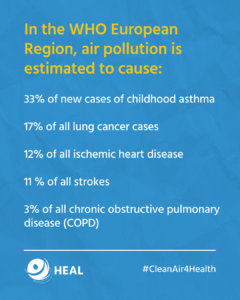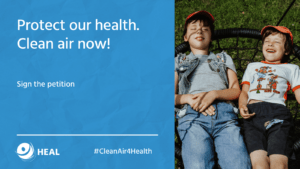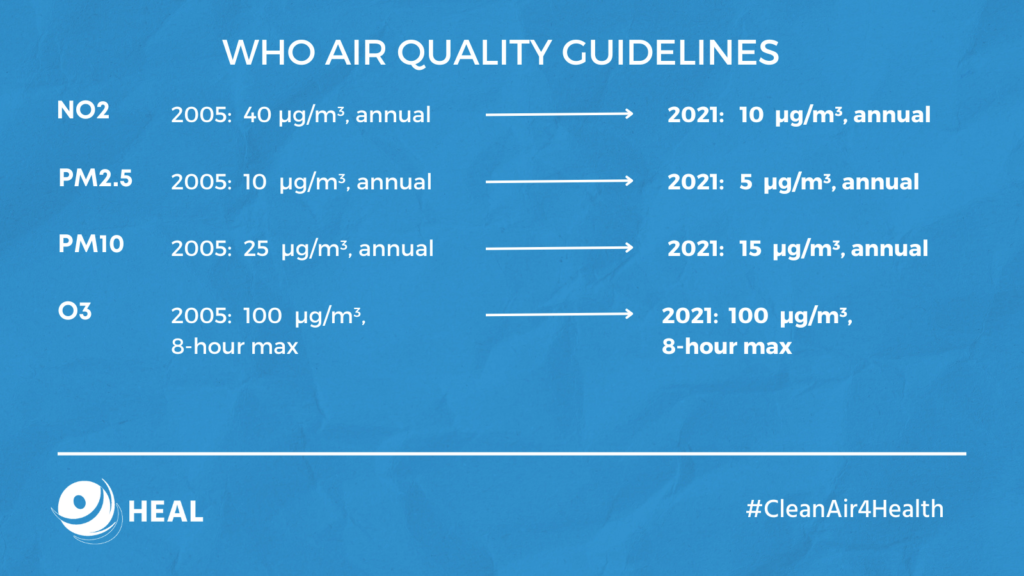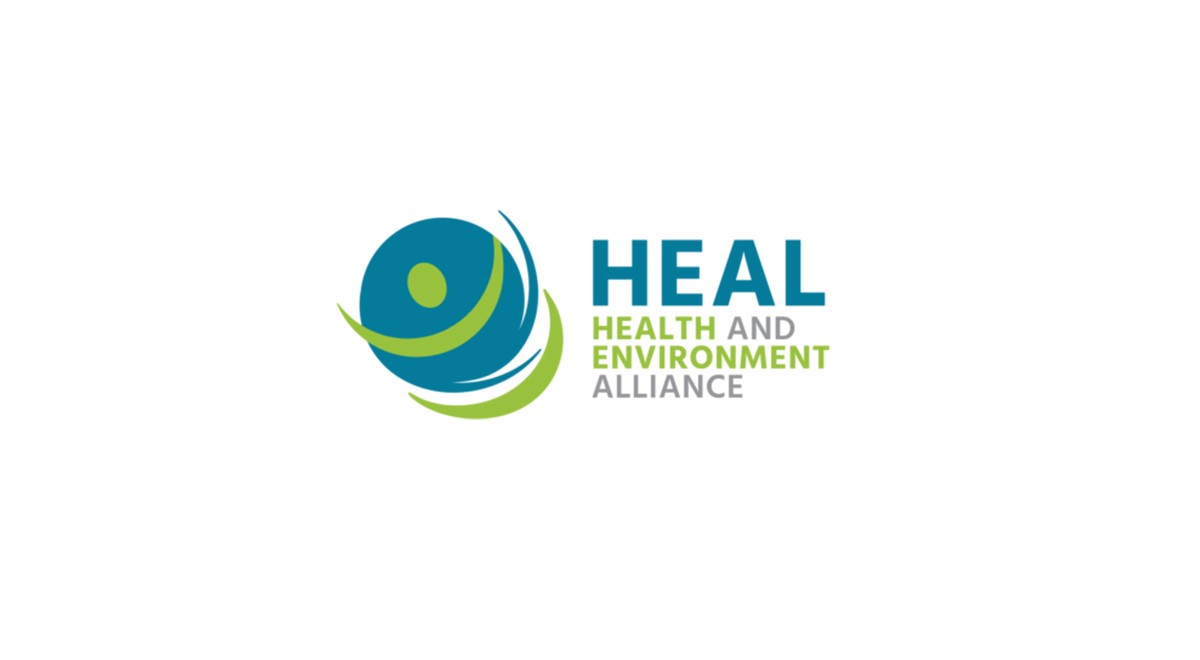Are you our new Communications Officer?
Air pollution is the number one environmental threat to health, in the EU and globally. HEAL works for good air quality indoors and outside that does not harm health, and to protect those that are particularly vulnerable.
Our vision is clean air for all, across the European continent, and reaching WHO’s air quality guidelines by 2030.
The health burden from poor air quality in the EU is unacceptably high, with hundreds of thousands of premature deaths and hundreds of billions of euros in health costs each year.
 Air pollution is one of the five main risk factors for non communicable diseases. In the WHO European Region, air pollution is estimated to cause about 33% of new cases of childhood asthma, 17% of all lung cancer cases, 12% of all ischemic heart disease, 11 % of all strokes, and 3% of all chronic obstructive pulmonary disease (COPD). Evidence on adverse effects of air pollution on diseases of the brain, including dementia and mental health, are rapidly emerging, and likely add to the increasing burden of air pollution. In addition, recent studies have shown that children are particularly at risk of harm from polluted air, given that their lungs, heart, brain, respiratory, immune and nervous systems are still developing. Their health can already be affected at early-life stages or even before birth, with lifelong consequences.
Air pollution is one of the five main risk factors for non communicable diseases. In the WHO European Region, air pollution is estimated to cause about 33% of new cases of childhood asthma, 17% of all lung cancer cases, 12% of all ischemic heart disease, 11 % of all strokes, and 3% of all chronic obstructive pulmonary disease (COPD). Evidence on adverse effects of air pollution on diseases of the brain, including dementia and mental health, are rapidly emerging, and likely add to the increasing burden of air pollution. In addition, recent studies have shown that children are particularly at risk of harm from polluted air, given that their lungs, heart, brain, respiratory, immune and nervous systems are still developing. Their health can already be affected at early-life stages or even before birth, with lifelong consequences.
Evidence is also growing regarding the harmful effects of low level pollution, pointing to the fact that there is likely no safe level of exposure to PM2.5 below which negative health effects aren’t seen.
Science-based clean air standards for the EU
The revision of the EU’s clean air standards is a not-to-be-missed opportunity for the EU to become a clean air champion in the region and internationally, which can lead to significant improvement in people’s health and the prevention of disease, including reduced rates of cancer, heart and lung disease among others. Strengthened clean air efforts will also support climate mitigation.
We call on the European Union to urgently, finally and fully align EU air quality standards with the latest available science to protect our health.
The latest WHO Air Quality Guidelines (2021)
In September 2021, the World Health Organization (WHO) published much awaited new evidence-based Global Air Quality guidelines, the first update since 2005. After a systematic review of the accumulated evidence, the WHO recommends lower values for several pollutants, most notably for particulate matter PM2.5, and for nitrogen dioxide (NO2).
Read our blog post about all things WHO Air Quality guidelines.
Full alignment of EU air quality standards with WHO guidelines by 2030
The health community recommends the transition to full alignment of EU air quality standards with WHO guidelines and the latest available science by 2030, outlining four goals:
- A rapid and urgent transition to clean air for all, everywhere in the EU by 2030
- Protection and prioritisation of those with one or multiple forms of biological or social vulnerability, such as children, older people, those already sick and people living in poverty
- Swift legislative process with clear steps and milestones reflecting the urgency to act
- EU financial and technical support to air pollution prevention in the European region (Western Balkans and Turkey)
Read HEAL’s position paper on Clean Air for Health Transition in the EU, 2021-2030 (available in EN, FR, DE, IT, PT, CZ, NL, SL, ES, SV, PL).
Letters to decision makers
With an open letter to EU-27 national ministers of health, HEAL in October 2021 invited the leading health bodies to be more involved in clean air efforts and to express their support for WHO aligned air quality standards. The letter was accompanied by a Q&A on air pollution and the benefits of clean air policies. The letter and/or Q&A are available in EN, BG, NL, IT, ES, PT, PL, SL, CZ, SV, PL.
In September 2022, exactly one year after the WHO had published new Global Air Quality Guidelines, more than 100 organisations in 17 EU countries called on their health and environment ministers to save lives and protect nature from air pollution with legally binding, science-based EU air quality standards.
The letter is available in EN, DE, FR, NL, CRO, HU, IT, PL, PT, SL, ES.
In December 2022, HEAL, together with CPME, EFA, AIM, EPHA and Mutualites Libres, has sent a joint letter to EU environment ministers, urging them to step up on the European Commission’s proposal for a review of the Ambient Air Quality Directive, to reduce ill-health and health cost swiftly and significantly.
Clean Air petition
 The petition calls for full alignment with science-based air quality standards.
The petition calls for full alignment with science-based air quality standards.
It is available in: EN, DE, FR, PL, IT, ES, BG, SL, PT, and CZ.
Q&A on health and air quality standards in the European Union
This primer explains why air pollution is a health concern, the main consequences of poor air quality, and the current legislative framework.
Newsletter: science for healthy air quality
There is no scientific doubt that air pollutants such as particulate matter PM2.5 or nitrogen dioxide NO2 harm our health and new studies are emerging every month further proving this link. Simultaneously, researchers are increasingly looking at the health benefits of particular air pollution solutions. Our Science for Healthy Air Quality newsletter keeps you up to date on the latest science.
Subscribe here or have a look at past issues: April 2023, July 2022, April 2022, February 2022, December 2021, October 2021, July 2021, May 2021
Read this next to find out more about HEAL’s work on air quality:
HEAL reports, briefings and infographics:
- Interactive infographic: HEAL’s demands for clean air, for everyone
- Infographic: why we need health-based clean air standards
- Infographic on walking and cycling
- Toolkit: Advocating for clean air – how to communicate the science
- Our healthy city of tomorrow – infographics and other materials in 6 languages
- Our healthy city of tomorrow – video
HEAL’s press statements and opinion pieces:
- Reactions from the health community on the European Commission’s proposal on updating the Ambient Air Quality Directive
- Blog post about WHO Air Quality guidelines
- HEAL’s reaction to the European Parliament’s vote on the López report on the implementation of the Ambient Air Quality Directives (AAQD)
- HEAL reaction to EU zero pollution action plan
- HEAL response to EU consultation on zero pollution
- HEAL feedback on Air quality – revision of EU rules
- Without prioritising walking and cycling, EU mobility strategy is a lost opportunity
- Ditch fossil fuelled transport to guarantee healthy air, study confirms



